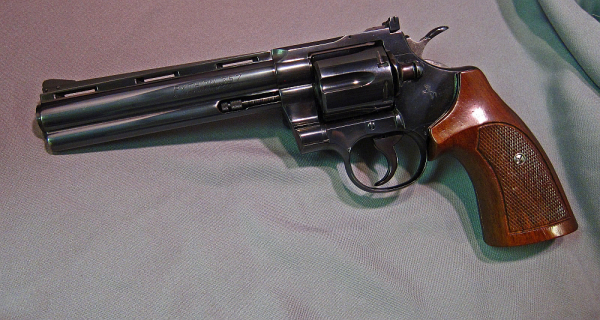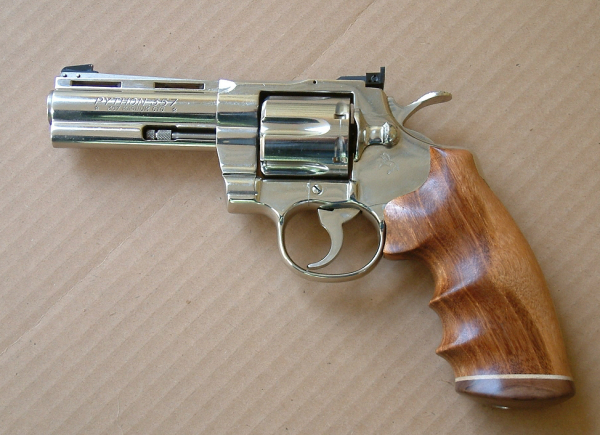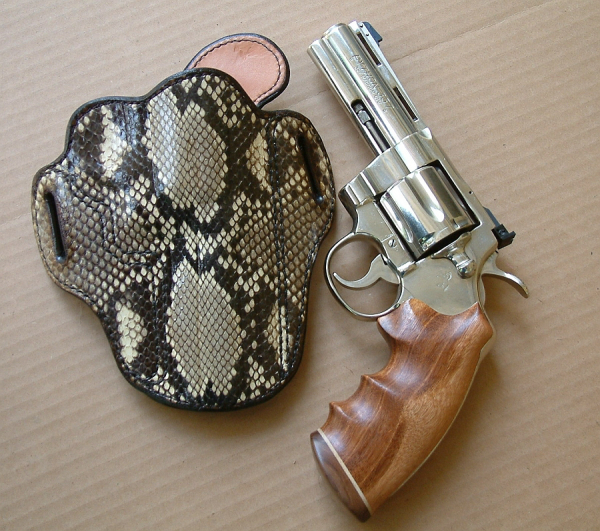Nearly 47 years ago, I bought my first centerfire handgun. I’d been sworn in early in the year, gone to Basic Combat Training, Advanced Individual Training and to a service school all courtesy of our Rich Uncle. My first posting as ‘permanent party’ was to Ft. Benning Georgia.
I’d signed in at Post, gotten an assignment and checked in there. Having some time, I played “tourist” meeting a personable NCO at “All-Army,” the US Army Marksmanship Training Unit. He showed me around, explained the then-fashionable “running boar” course upon which they competed internationally. I got to shoot a real Army rifle, the 1873 Springfield, loaded with real Army ammo, a black powder cartridge.
It was a lot of rifle compared to the XM16E2 I’d used in BCT – in terms of weight, length and caliber.
After a few months, I noted a classified ad promoting a Colt Python for sale. The transferor was another GI, this one living off-post in Phenix City, AL across the line from Columbus GA, the home of Ft. Benning, the Infantry and Airborne schools.
I made the trip and found a six-inch blue revolver, made then in only 357 Magnum. The hapless GI had purchased it for his wife to have when he was away and had taken a rasp to the large Colt target stocks. He also had a set of small stocks meant for the Colt Official Police, these were after-market. Even with the tiniest of gripping surface, she found the 41-ounce wheel gun to be a bit much.

The Colt Python showed up on Earth shortly after I had, an effort to make the deluxe revolver. Colt had already taken the Colt Officer’s Model, the real one – a 38 revolver not a sawn-off Government Model 1911, and made the Officer’s Model Match. This .41 frame double action revolver was, as the name implied, meant for police service like Colt’s Official Police. The OMM originally chambered 38 Special, though I’ve seen some in 22 LR and 22 Mag. The enhancements included sights, a nicely tapered match barrel and a beavertail hammer spur.
According to the history I found, Colt manufactured several double action revolvers in their history. The “E&I frame” double action revolvers included the Official Police, Commando, Officer’s Model Match, Colt Three-Fifty-Seven, the original Trooper (first in .38 Special and then in .357 Magnum) and the Python. They share the same frame and, largely, the same action. I believe the Colt 357 was the first to feature the target hammer and the first to have a frame mounted (not hammer-mounted) firing pin. The Python took those assets with it.
The barrel of the Python doesn’t taper rear-to-front like the Three-Fifty-Seven’s, and has added weight in the form of the solid under lug. Unlike the previous guns, a vent rib graces the top of the Python barrel.
This was in an era when bullseye was the big game for handguns on the cusp of the police-only PPC competitions which would shortly follow. Both games involved extreme precision handgun accuracy inside some (now considered “generous”) time constraints. The 38 Special was king of the hill for these pursuits. Along with the 45 ACP, the 38 Special was the most-developed handgun cartridge (for accuracy) in US history.
According to those who were there, the OMM was doing quite well in the bullseye game but word came from sales that a true “Cadillac” would be just the ticket. They had the Hartford staff work on the guns, but it quickly turned into a Magnum revolver – it was backwards compatible to the 38 Special but they figured it would have more appeal to the cops (and, eventually, hunters).

The Python’s rifling twist was quicker than their big competitor’s product and the bores slugged tighter. There was a bit of a foreward taper to the bore too, or so I was told. The adjustable sights – protected Accro adjustable in the rear with the more target-friendly Elliason added by some later – sat atop the premium finished frame. That high gloss was matched on the barrel atop which a ventilated sighting rib sat. The rib was vented to cut weight; the revolver was plenty muzzle heavy without adding more weight up front. The typical front sight was ramped to prevent snagging leather and putting a fuzzy sight picture in front of the competitor. The real revolvereros would put the flat-faced Elliason on the rear and match it to a patridge front sight with its sharp profile – making it like the front sight on the Officer’s Model Match.
The Python, like other Colts of the era, could develop timing issues and it took a real mechanic to sort that out. While there were many who did action jobs on S&W revolvers, a relative few had the mettle to approach the Colt’s action.
My history with the big Magnum is fairly minor. I knew two guys who carried Pythons on the job, one a six-inch and the other a four-inch gun. On my first cop job, they had an opening on the pistol team which would travel to the state peace officers’ association spring and fall conferences. During the festivities, there would be a bullseye match and a PPC match.
I shot for the team and was accepted for the Spring Conference of 1979. I had a S&W M14 that someone had tried to reconfigure for PPC. And I had the Python for bullseye. I loaded my own 38 wadcutter ammo using factory swaged bullets, Hercules Bullseye powder and brass I’d painstakingly sorted. I weighed individual powder charges, cleaned the brass, inspected every bullet before loading.
An academy classmate worked at a nearby agency which apparently spent more on their pistol team: they were issued ammo to fit the department’s S&W Model 52 a semi-auto target pistol, chambered in .38 Special (wadcutter only) for bullseye match shooting. He was in the group at that conference and, as “novices,” we shot against each other. I got the Novice Award by shading him just a little bit.
I had to thumb-cock the Snake for each shot; he simply had to hold and press and the gun did the loading and cocking for him. I had a lovely slowfire score, a personal best. Timed wasn’t as good and rapid was a mess. Still, there were enough points and it said more for the Python than it did for its user.

Many years later, my bride and I were in the nearby Cabela’s store and she saw a four-inch Python, nickeled. She knew that my first centerfire handgun was the Colt Python and she said if I could make a deal, I could get that for my fiftieth birthday.
The deal was made. The very competent, nice folks at Cylinder & Slide sorted out the action and installed sights. Hogue kindly took the frame in and fitted their fine wood stocks to it, making this my “half-century” Python, acquired 32 years after the first.
With the modern accessibility of information, I checked into the manufacture date of both of these fine old guns. Using the Colt "Serial Lookup" page, I found the first one was manufactured in 1968, the shorter gun made in 1981.
The Colt Python started my trip down the centerfire handgun road. It’ll always be a special memory for me. I’ve moved past it for practical reasons. But no handgun is as classy as this one.
- - Rich Grassi